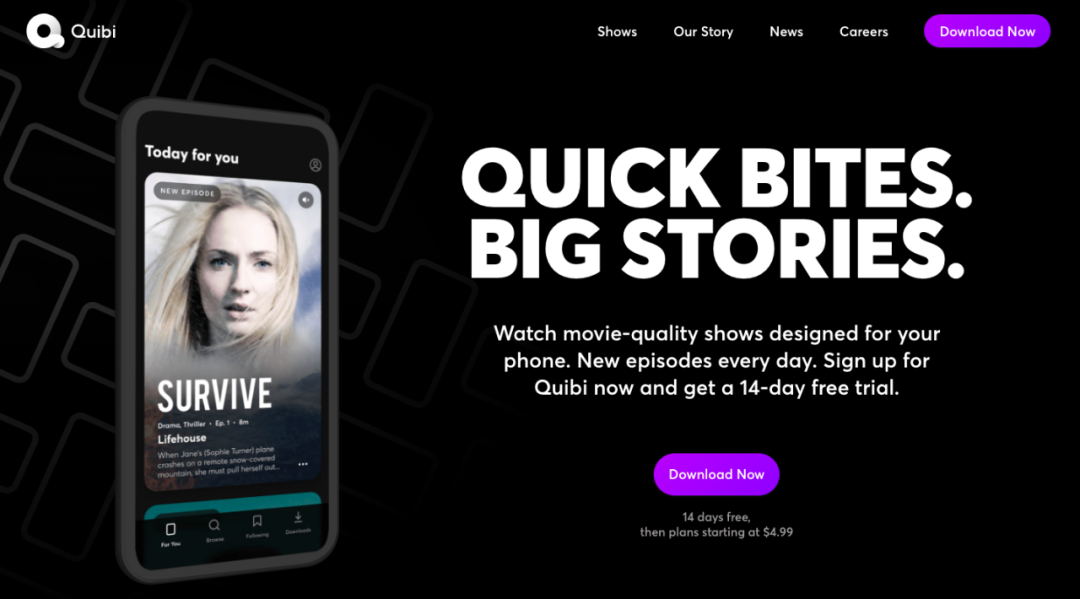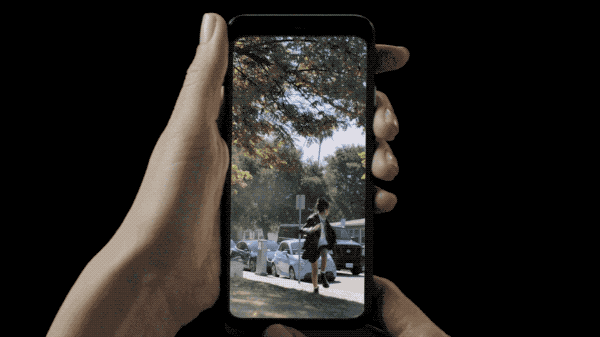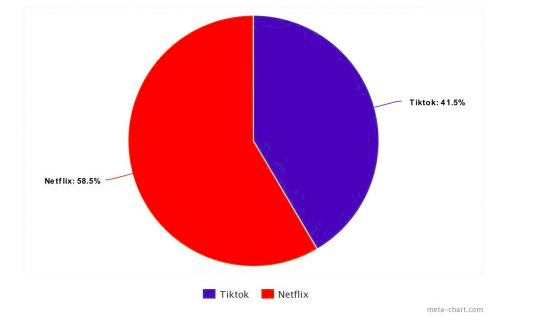So far, the most tragic failure of the streaming media war.
Editor’s note: This article is from the WeChat public account “New Culture Business” (ID: Ent-Biz), author: Amy Wang.
“We think we have tried all the options, but we still have to make the difficult decision, which is to close the company, return the cash to our shareholders, and say goodbye to our colleagues.” With QUIBI founder Jeffrey Katzenberg and This post by CEO Meg Whitman was released, and the QUIBI server was officially shut down.
The Guardian commented on QUIBI like this: Born in the LA conference room, died in the real world. It was officially launched on April 7, 2020 EST, and closed on October 21, 2020. This Hollywood short video streaming blockbuster has a lifespan of only 199 days. It raised a total of US$1.75 billion (remaining 350 million in cash), which means that an average of US$7 million (approximately 47 million yuan) will be burned every day for 199 days.
Quibi’s death is an important moment for streaming media and Hollywood. It records how Hollywood became irrational due to the impact of streaming media, how the top content of the short video battlefield was shredded by grassroots, and recorded the vacuum between the Netflix mode and the Tik Tok mode. A search failed.
For founder Katzenberg, this entrepreneurial class is extremely painful. In addition to objective reasons, subjectively, Katzenberg only throws checks through his circle of friends, and does not have the innovative technologies and models that lead the world. After all, it is a waste of money.
From its birth to its death, QUIBI is destined to be just a commercial experiment in which a long video that is costly, ambitious, and regrettable is shortened.
Behind the most spectacular failure in the streaming media war so far, people in the game have to think about where the Internet + content industry is going, how to break the barrier, and whether new species exist or not. There are many problems, but no methodology. Perhaps the death of QUIBI can deepen people’s thinking on several basic issues, such as:
1. What is the essence of long video and short video?
2. Content commercial monetization model and hidden content lengthWith relationship;
3. How to match social, content, and technology to bring stability and sustainability to business;
4. The threshold for content entrepreneurship under the “winner takes all” situation;
……
Quibi, which was not favored from his background, was defeated by “twisting Ba”
Quibi is a high-end paid short video streaming media specially created for mobile phones.
At the beginning of its establishment, from the imaginative construction of the product, to the founding team of Hollywood with rich experience, and to the luxurious father and father group behind it, QUIBI is a combination of content and technology in 2020. It’s not an exaggeration to be named “Hollywood Tik Tok” and “Short Video Netflix” for heavy seed players.
However, since the launch of the product on April 6 this year, QUIBI’s performance has not been very good. It was reported by foreign media yesterday that it had laid off 10% of its staff. The executives took the initiative to cut their salaries to deal with the problem of insufficient cash. In just two months, this professional The new paid short video applications in the content field have shown numerous problems.
The target audience is millennials, with a single 10-minute high-quality short series. Unlike other streaming media, Quibi’s content only supports streaming on mobile devices, supports landscape and portrait viewing, and users can seamlessly switch between landscape and portrait. Quibi’s interface is very similar to the TikTok information stream. Once you open the program card list, the user selects the content to watch by sliding up and down. When the stay time is a little longer, the system will automatically play the current video content.
From the perspective of business model, Quibi supports subscription and advertising, and it seems to be a combination of Youtube and Netflix. However, according to the current function setting and content planning, the payment is greater than the advertisement. It is rumored that Quibi will sell out all its $150 million advertising inventory in 2020 before and after its launch. Customers include Anheuser-Busch, Discover, General Mills, Google, Procter & Gamble, Pepsi, Walmart and other brands. But it mainly relies on paid membership subscriptions for professional short content. The company announced that if you register before the end of April, users can enjoy 90 days of free movie viewing services. After the expiration, there are two renewal options of $4.99/month (including ads) or $7.99/month ( No ads). This is cheaper than Netflix, Apple+, Disney+.
Quibi plans to spend $1.1 billion in the first year for debugging original content, including 8500 short series, more than 175 performances, the content format covers movies, sitcoms, reality shows, documentaries, news.
The seemingly perfect idea did not receive an enthusiastic response from the market. Quibi was officially released in the United States and Canada on April 6 this year. One week after the release, it received 1.7 million downloads immediately, ranking among the TOP50 iPhone free download apps in the United States; by the beginning of May, the app’s ranking dropped to 125th; in early June, the company was exposed to layoffs and executives taking the lead in salary cuts. The application has fallen to 1,000 in the Sensor Tower ranking. According to foreign media reports, as of the server shutdown, there were less than 500,000 users on QUIBI.
Want to grab the paid revenue of long videos and the advertising revenue of short videos. This idea should have been good. But for QUIBI, its product construction is based on a profit model, not user needs. One problem with the idea of spending a lot of money to ask the top Hollywood teams to shoot short video content, and then collect the money for the long video in the length of the short video, is that it ignores that the nature of short video is actually social, rather than well-made content itself.
Facts have proved that QUIBI has not produced breakthrough content that is enough to attract users, and it does not have almost unlimited supply of free content on other platforms such as YouTube and TikTok to cope with competition.
The boundary of the content industry depends on the duration or the investment?
The essence of long video is content, and the payment model is based on the premium sale of content.
QUIBI, which is positioned in the middle ground, can neither grab long video users nor short video users. It is foreseeable that with the privilege of free experience in April, early users can download and watch. With the advent of charges, promotion quickly hit a freezing point. Because customer acquisition results were much lower than expected, in August, Quibi tested the free version in Australia and New Zealand in an attempt to find a little bit of life from learning the advertising model of Youtube and Tik Tok, but it also had little effect. In the end, the founder team sought a face. After Shu and other companies were rejected, they chose to close.
“Cuba” has been pushed to the extreme when QUIBI promised three months of free experience for new users. The pay rate and retention rate are less than 8%, so QUIBI completely bows to free.
Another point is that beginning in 2019, byte beating, Kaishou began to open the permission for videos longer than 10 minutes to fans with huge short Video bloggers encourage them to produce more sophisticated 10-minute “long” content, and the platform does not need to pay additional content costs.
QUIBI is taking the completely opposite path, burning money to produce content-to win users-to attract short video content bloggers like Youtuber. For Tik Tok, which currently has 2 billion installed capacity in the world, once its 10-minute function is powerful, the function of QUIBI may be just a small branch of it, which will soon be covered by the flood.
The proportion of tik tok and netflix used by students
Born in the cracks between tik tok and the co-pandemic of new coronary pneumonia, it was a very bad luck thing for QUIBI. The tik tok pandemic is a big change for QUIBI. After all, when the founder of QUIBI raised $1 billion with PPT, Douyin had not yet been accepted by the market.
Monetizing from the launch of QUIBI has also led to the discussion of another question, that is, in the content field, is there an inevitable connection between duration and business model?
Short videos represented by Douyin are currently absolutely free. Information flow advertising and e-commerce have become the main revenue sources, while long video streaming represented by Netflix is absolutely paid. Platforms and content producers, platforms and users Form a clear contractual relationship between the sale and purchase. QUIBI tried to find the middle ground. Although it cannot be regarded as a complete failure at present, it seems difficult to counterattack.
China’s long-term video streaming media Aiyouten, which has always had advertising and paid formats, is at a loss. Whether there is a middle ground between absolute payment and absolute free, the birth of new species is still a very important issue. Things to look forward to.
Is there a golden ratio of technology, content, and social interaction?
If the core of short video is social, then technology and content have become the absolute cooperating factor. All technical experience and content need to serve strong social interaction. This has been verified by Douyin..
If the core of a long video is content, then technology and social interaction have become absolutely cooperating factors. All technical experience and sociality need to be closely linked to content. This has been verified by Netflix.
Although the AI and 5G era has come, it is still wrong to overemphasize technology without the input and output of business itself. Many technology companies are guilty of this problem. QUIBI is more typical. It just pays too much attention to content and technical experience, reducing the social attributes to almost zero. Although it has a horizontal and vertical screen that can be seamlessly switched, the content created by the top Hollywood team, But users cannot take screenshots, cannot share, and lose their enthusiasm for discussion and dissemination.
From this point of view, it seems overly arrogant.
At present, Internet companies are trying to seize the high point of AI and 5G and create barriers to competition, but in fact, when technology is stained with content and social networking, it becomes extremely pale, because these three variables are together, and the most difficult to copy is often It’s content and social. Technology is a tool, it can make things better and cooler, but it cannot change things themselves.
Golden ratio may not exist, but in the most money-burning entertainment industry, a little more attention to input and output, a little less yearning for business stories, and a return to the essence of business, may be able to be in these three A better ratio of elements has been found to cope with the increasingly complex competitive situation.
Under the winner-takes-all, the threshold for Internet + content entrepreneurship is higher than imagined
The founder Katzenberg said in a statement: “Since Quibi was launched, the world has changed drastically and our independent business model is no longer feasible.”
In 2018, Quibi raised $1 billion in funding from 11 investors and major Hollywood movie studios, including Disney, NBCUniversal, Sony Pictures, Warner, Liberty Global, ViacomCBS and Alibaba etc. Katzenberg tries to challenge the most successful formula used by almost all start-ups from cable TV channels to Netflix.
From the statement announcing the closure, it can be seen that the founder, Katzenberg, attributed the main reason for the error to COVID-19, because the new crown pneumonia broke the normal release rhythm of the product. According to the original plan, QUIBI’s online press conference was a grand event comparable to the Oscars. At least 150 Hollywood stars were invited to walk on the red carpet, lasting 3 hours, and 200 media were invited to report on the spot.
Fortunately, there is no press conference, otherwise this failure will appear more tragic.
Although QUIBI is short-lived, it has to admit that the threshold for starting a business is extremely high. One of the founders, Katzenberg, is a veteran who founded DreamWorks. He sold his Glendale-based studio to NBCUniversal for $3.8 billion in 2016. He also led Disney through the 1990s. The animation renaissance is self-evident in Hollywood. The CEO is the former eBay and HP CEO Meg Whitman, who has a lot of experience in business and management, not to mention the super team behind the team.
As a well-known Hollywood billionaire, in the era of short video and streaming media, he was placed on the gaming table with the hope of a “gamble” comeback.
For emerging entrepreneurial teams, the threshold of “Internet + content” entrepreneurship is getting higher and higher. The six major Hollywood monopolies are the earliest monopolies formed in the upstream content. They have lasted for nearly a hundred years and are still full of vitality. In terms of Internet streaming media, Netflix, youtube, and tik tok are forming new monopolies. Even if there are competitors, they are Apple, Disney, Facebook, etc. Oligopoly in other fields. Not only the entrepreneurial project, the founder and the leadership team, and the financial support must be absolutely perfect, but also good luck from heaven. Any mistake in any link will be forever.
QUIBI seems to have a very tempting option for latecomers, even if it doesn’t want to admit it. To reiterate, product failure is not terrible. Innovation, challenge and continuous thinking are the roots of the continuous birth of this industry.




